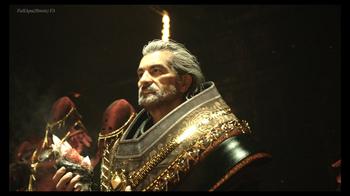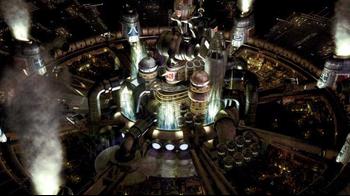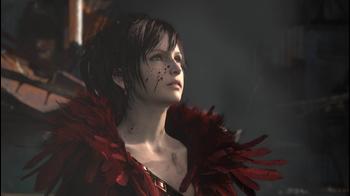
Agni's Philosophy Final Fantasy Realtime Tech Demo Impressions
Perhaps the most interesting and engaging thing to come out this year’s E3 lies within Agni’s Philosophy – a visionary tech demo created by Square Enix’s own Luminous Studio who’ve imagined their own concept of Final Fantasy.
Luminous Studio’s own Luminous Engine was first revealed back in 2010 with production of the Philosophy demo beginning as early as June of last year. Since then the size of the team has grown, amounting to 1/3 of the total being from places outside of Japan.
We had the rare chance to sit down with the minds at Luminous Studio including Yoshihisa Hashimoto, Takeshi Nozue, Akira Iwata and Hiroshi Iwasaki for a one hour closed demo of Agni’s Philosophy and came away simply more than impressed.
The demonstration began with a repeat of the Philosophy demo which we’d only seen online until then. Viewing a non-compressed full resolution version was quite a sight coupled with the brilliant sound quality of Square’s set up on a big TV. The visual fidelity is so great; one could almost mistake it as CG.
If you haven’t seen it yourself, the video is readily available, although somewhat compressed and not up to full quality.
Following the video, we were shown the actual demo itself to get a better look at it running in real time on an actual PC.
From the beginning of the demo, Hashimoto-san focused in on the old man who appears in the first scene. There are several scenes in the demo, of course, but for this one they showed us how they were going to edit it in real time. By taking control of the scene, Hashimoto was able to stop time at any specific moment and move the camera around – we were able to see various assets still in development that proved that yes, these are real graphics running off of a real PC; nothing is “pre-rendered” here.
Following that, Hashimoto decided to edit the old man’s beard – the shape, color, and length can all be modified instantly using the tools Luminous has to offer. By using the tools, he made the man’s beard grow longer, and then by opening a color selection tool, he turned it into a florescent pink. The engine’s physics reacted instantly to the beard being longer.
“Of course, we can change it in lots of ways. It has very complicated shading by the GPU,” said Hashimoto. So does the engine then compensate for whatever you do to the hair’s length? “That’s right, actually there’s a curve data. Based on that in the GPU, it’s generated in polygons.”
We asked, “That will be used for clothes and other stuff to then?” to which Hashimoto replied, “Yes, the same technology is used.”
Hashimoto then proceeded to make the beard big, thick and white; much like Santa Claus!
In the next scene, the priest is summoning hundreds of thousands of insects. They are part of a monster that is materializing in front of the group of robed people. Due to the TV we were viewing the demo on, the scene was a little darker than usual, but again it was possible for the demo to be stopped and the camera to be controlled freely.
Messing around with the tools once again, Hashimoto showed us the same scene with depth of field turned off, making the view much clearer. The monsters are actually a polygon mesh – they’re not a light ball. They have bodies, wings – every single one of them does. There are about 100,000 insects in total – each an individual full polygon model. This section of the demo was running at around 30 frames per second.
They looked a lot like fireflies with the way they were illuminated. These insects were actually generating flesh on the summoned monster. “Can you see how the flesh is being generated and created slowly in from the right side? This is special processing that's taking place in the GPU, to have the flesh created like this,” said Hashimoto. The insects are feeding the flesh, the bones – and then it becomes bigger and bigger flesh as the monster is revived due to the priest’s praying.
“Can you identify the difference between these polygon insect models and just the light balls used previously? We can change the size and edit them in real time, too.”
The next scene features Agni in the lower right. She’s the protagonist of this story, in case you were wondering. Just a moment ago, she was in the process of learning magic. Her character model is quite spectacular – the team really focused on creating the hair, the eyes, and the skin. One of the key focuses here was on the expressions of the people in the demo. Agni’s hair is actually similar to that of the old man’s – it can be modified in real time.
With Agni’s Philosophy the team aimed to achieve the same level of quality as a CG movie. As such, Visual Works actually created the clip in full CG form as a sort of template. Hashimoto proceeded to show us a demonstration of the two running side by side.
The right side of the screen was the CG version while the left side was a video of the real time production. Although the CG side was incomplete – missing various elements such as unfinished hair – it still served to show a great example of how close the real time graphics had come to the pre-rendered. Hashimoto said that using Luminous, you can basically take CG assets and port them into the engine for use in a game. The backgrounds such as the mountains and houses are the same assets featured in the Visual Works version of the demo, as and such were not built to be real time assets.
Quite honestly it was hard to see much of a difference between the two. Hair and lighting looked a bit better on the CG side of things, and maybe some textures, but over all the real time version came ridiculously close.
Of course, with CG-level assets disc space will likely be an issue. The team thinks that even Blu-ray might not be enough space, but they must consider the careful compression of data.
Toward the end of the presentation, Hashimoto and his team decided to inquire upon our own opinions involving things like the world concept, recent Final Fantasy titles and the heroine Agni. “Let me ask you a question! If we had a game like this, would you like to play it?”
Truth be told, the direction of the Final Fantasy series during the past few years has been less than appealing. Artistically Agni’s Philosophy looks better than XIII did, but without knowing how it would play we’re still cautious. If we’re to base it just on looks, then yes – I think it would be a game I’d like to play, with some exceptions of course.
Hashimoto then asked us how we felt about Agni and the difference between that demo and Final Fantasy XIII. Perhaps Final Fantasy has grown a bit predictable lately. It’s hard to say on the spot, but this new tech demo feels quite different; almost refreshing. Hashimoto explained that when they discussed the concept of “What is Final Fantasy” they tried to narrow down the core necessities while filtering out other aspects. They also added in things that have never been in the series before.
When I first saw it, I didn’t think it was a Final Fantasy tech demo, I thought it was just an original concept. When I saw the Final Fantasy name attached I got really excited about it – the idea of taking a concept that I love and applying it to new and exciting things. Going back to XIII and XIII-2, those games played differently than anything that came before, but I think the visual aspect is equally important.
For me I think I miss some of the spectacle. No individual moment from XIII really stands up to the famous zoom out from Midgar, or the coin toss in FFVI, or Alexander bursting from the castle in FFIX – those moments are burned into my mind. I get the impression from Agni’s Philosophy that it could have those types of moments even though it’s just a movie.
I think the one thing that really stands about this demo is that the main character actually looks like a real person. That’s one of the main reasons why I’m very interested in Final Fantasy Versus XIII as it’s going for a more realistic look and feel and that is what I’d like to see in a Final Fantasy game – a more realistic/dark modern fantasy. With this, it’s very evident that the people look real, and the setting is realistic to where it feels like it could exist in real life while still retaining fantasy elements.
In terms of the more recent titles, I really liked Final Fantasy XII, but with XIII and XIII-2 I didn’t think the world or characters very interesting or relatable. Looking at games like Final Fantasy VII and IX, you could really care for those characters and their stories and what was happening to them – so I think if there’s a return to things like that, fans would be really happy.
From a female perspective, I really like the way Agni looks over say, someone like Lightning. I feel she’s not a “forced” heroine – that they’re not just forcing a female protagonist into the world by giving into stereotypes on opposite sides of the spectrum. She’s not some spell-slinging warrior who just charges right in on things. The opening to Final Fantasy XIII just left a bad taste in my mouth, whereas with Agni, the fact that she’s running away and things aren’t going great – I actually kind of like that.
The team told us when they were developing the concept for Agni they decided that magic cannot come so easily. For her to use magic, it’s really challenging so when she uses lightning, she gets burned. Something like that tends to be a bit more believable I think.
Despite the premise, however, the most important thing to remember here is that Agni’s Philosophy is still very much a tech demo at the core. The team has stressed multiple times that it’s not a game, although how much truth lies behind that has come into question. Why is Square Enix polling users for feedback? Why are they showing the demo at multiple venues? If not to convince people to come to their cause, perhaps something even greater is happening behind the scenes.
Another important thing to think about is the cold hard truth of realistic expectations. Square has done tech demos before and every single one of them, ranging from FFVI on the N64 to FFVII on PS3 (and perhaps even FFXIII’s E3 2006 target render…) never lived up to all of their perceived promises. Luminous might look nice on the outside, but how it will actually handle a playable game is an entirely different matter. With the engine likely not going into full application until 6+ months from now, a full game with it won’t be ready for at least 3 or more years, depending of course on management and project resource budgeting.
Like all great things, it seems we must wait.




